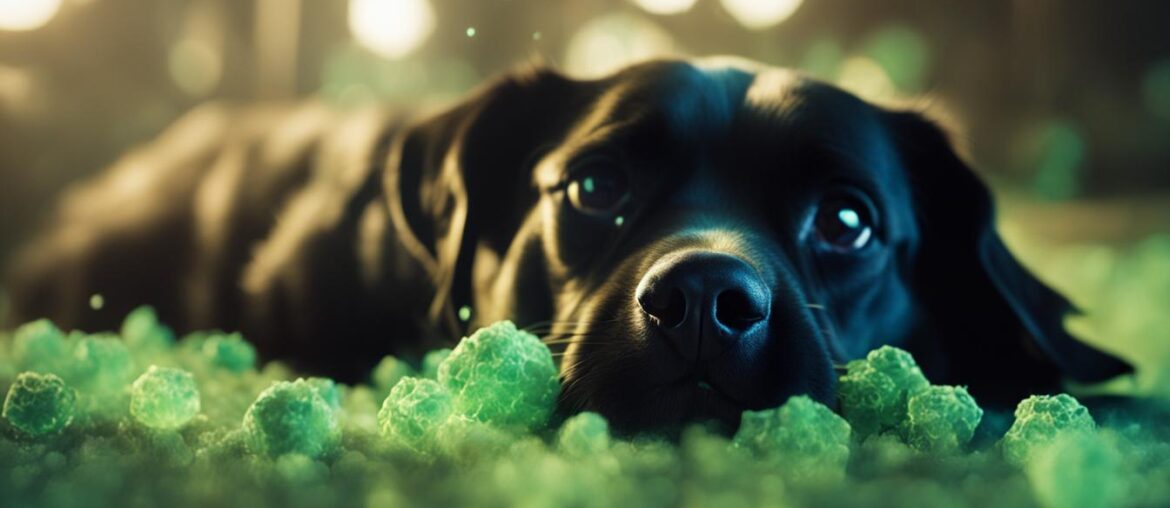As a pet owner, you may be concerned about the health of your furry companion, especially when it comes to contagious diseases. One such disease that has been making headlines is norovirus, the leading cause of foodborne illness in the US.
But can dogs get norovirus? Recent research suggests that dogs may indeed be able to contract and potentially transmit the human norovirus. Studies have shown evidence of dogs mounting an immune response to human norovirus, indicating that they have been infected. Additionally, human norovirus can bind to the cells of the canine gut, suggesting that infection is theoretically possible.
However, it’s important to note that no evidence has been found that dogs can shed the virus in quantities sufficient to infect humans. Nevertheless, further investigation is needed to fully understand the potential risks of dogs transmitting norovirus to humans.
Key Takeaways:
- Dogs may be able to contract and potentially transmit the human norovirus.
- No evidence has been found that dogs can shed the virus in quantities sufficient to infect humans.
- Further investigation is needed to fully understand the potential risks of dogs transmitting norovirus to humans.
Can Humans Pass Norovirus to Dogs?

Recent research has shown that humans may be able to pass norovirus, specifically the human norovirus strain, to dogs. Studies have found dogs with human norovirus in their stool samples, indicating that they may have been infected by the virus. Additionally, kennel outbreaks have been traced to pregnant dogs who were moved from the kennel to live indoors with infected people, resulting in the transmission of norovirus to both the dogs and the puppies they birthed. While it is possible for humans to transfer the virus to dogs, it is important to note that gastroenteritis in dogs can be caused by various factors, including bacterial and viral infections, dietary issues, and underlying medical conditions.
To understand the potential transmission of norovirus from humans to dogs, let’s take a closer look at the findings:
- Dogs have been found with human norovirus in their stool samples
- Kennel outbreaks have resulted in norovirus transmission from infected people to pregnant dogs and their puppies
While humans can pass norovirus to dogs, it’s crucial to consider that gastroenteritis in dogs can be caused by other factors as well:
- Bacterial and viral infections
- Dietary issues
- Underlying medical conditions
It’s important to note the similarities and differences between gastroenteritis in humans and dogs. For a proper diagnosis and treatment plan, consultation with a veterinarian is essential.
The risk of transmission
According to recent studies, humans can potentially transmit the human norovirus strain to dogs. These findings indicate that dogs can become infected if exposed to the virus. In kennel environments, pregnant dogs have been identified as a source of norovirus transmission to both dogs and their puppies. However, it’s important to note that norovirus in dogs can also originate from other sources.
“While it is possible for humans to transfer the virus to dogs, it is important to note that gastroenteritis in dogs can be caused by various factors, including bacterial and viral infections, dietary issues, and underlying medical conditions.”
Understanding the potential transmission of norovirus between humans and dogs is crucial in preventing and managing the spread of the virus.
Relevant research and findings
Research has shown that dogs can harbor human norovirus in their stool samples. This suggests that dogs can become infected with the virus and potentially serve as a reservoir for transmission. Additionally, kennel outbreaks have been linked to the movement of pregnant dogs from the kennel to live indoors with infected individuals. These outbreaks resulted in the transmission of norovirus to the dogs and the puppies they birthed.
To emphasize the potential risk of transmission, here is a table summarizing the findings:
| Human Norovirus Transmission to Dogs | Research Findings |
|---|---|
| Dogs with human norovirus in their stool samples | Indicates potential infection |
| Kennel outbreaks resulting in norovirus transmission to dogs and puppies | Highlights potential transmission routes |
While these findings indicate the possibility of humans passing norovirus to dogs, further research is needed to fully understand the risks and preventive measures necessary to protect both humans and dogs.
Symptoms of Norovirus in Dogs
Dogs infected with norovirus may exhibit symptoms similar to those seen in humans with gastroenteritis. These symptoms may include:
- Severe vomiting and diarrhea
- Dehydration
- Loss of appetite
- Lethargy
- Blood in feces or vomit
- Abdominal pain
- Weakness
It is important to note that these symptoms can also be caused by other conditions, and that a proper diagnosis from a veterinarian is necessary to confirm norovirus infection.
Diagnosing Norovirus in Dogs
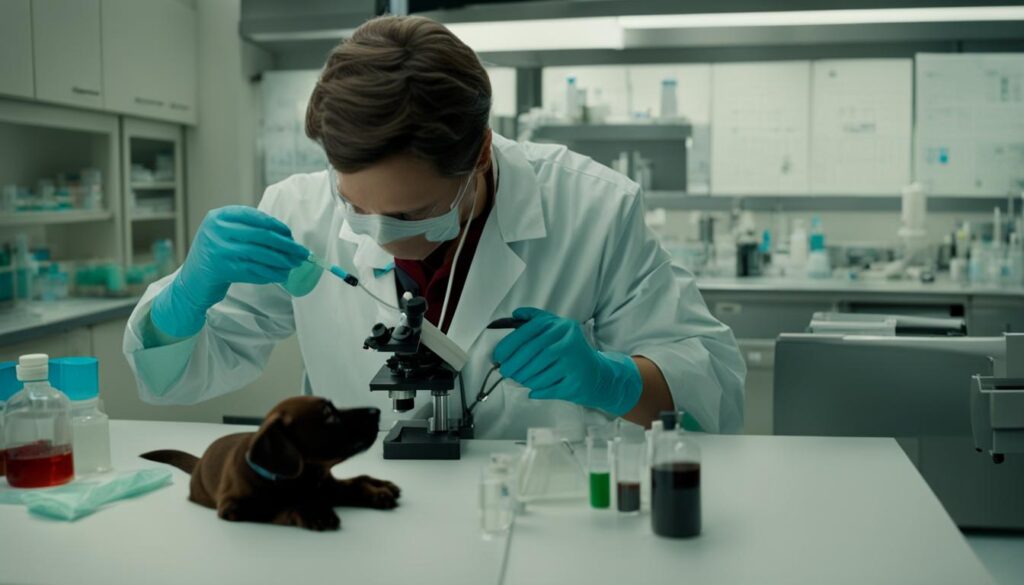
Diagnosing norovirus in dogs requires a thorough examination by a veterinarian. The most common sign of gastroenteritis in dogs is the sudden onset of severe vomiting and/or diarrhea.
A veterinarian will likely ask questions about the dog’s diet, potential exposure to norovirus-infected individuals, recent episodes of vomiting or diarrhea, and any medications the dog may be on. The vet may also run blood tests, order x-rays or scans, perform electrolyte tests, and conduct a urinalysis to check for any imbalances or underlying medical conditions.
Proper diagnosis is essential for determining the appropriate treatment plan and managing the symptoms effectively. By conducting a comprehensive examination and considering the dog’s medical history, the veterinarian can make an accurate diagnosis and rule out other possible causes of gastroenteritis.
Common diagnostic procedures for norovirus in dogs:
- Physical examination: The vet will assess the dog’s overall health, check for signs of dehydration, and carefully examine the abdomen.
- Questioning: The veterinarian will ask detailed questions about the dog’s symptoms, recent activities, and medical history to gather information relevant to the diagnosis.
- Blood tests: These tests help identify changes in blood chemistry that may indicate norovirus infection or other underlying health issues.
- X-rays or scans: Imaging tests can provide a clearer picture of the dog’s gastrointestinal tract, helping detect abnormalities or signs of inflammation.
- Electrolyte tests: These tests determine the levels of key minerals and electrolytes in the dog’s body, which can be important in assessing dehydration and overall health status.
- Urinalysis: A urine examination can provide insights into kidney function and detect potential urinary tract infections or other related conditions.
- Stool analysis: Collecting and analyzing a fecal sample can help identify the presence of norovirus or other pathogens.
By combining these diagnostic procedures, veterinarians can accurately diagnose norovirus in dogs and develop an appropriate treatment plan to address the symptoms and promote recovery.
| Diagnostic Procedures for Norovirus in Dogs | Description |
|---|---|
| Physical examination | An overall assessment of the dog’s health, focusing on signs of dehydration and abdominal abnormalities. |
| Questioning | Detailed questioning about the dog’s symptoms, activities, and medical history to gather relevant information for diagnosis. |
| Blood tests | Analysis of blood samples to identify changes in blood chemistry that may indicate norovirus infection or other health issues. |
| X-rays or scans | Imaging tests to visualize the gastrointestinal tract and detect abnormalities or signs of inflammation. |
| Electrolyte tests | Measurement of key minerals and electrolyte levels in the dog’s body to assess hydration and overall health status. |
| Urinalysis | Examination of urine to evaluate kidney function and detect potential urinary tract infections or related conditions. |
| Stool analysis | Collection and analysis of a fecal sample to identify the presence of norovirus or other pathogens. |
Treatment for Norovirus in Dogs
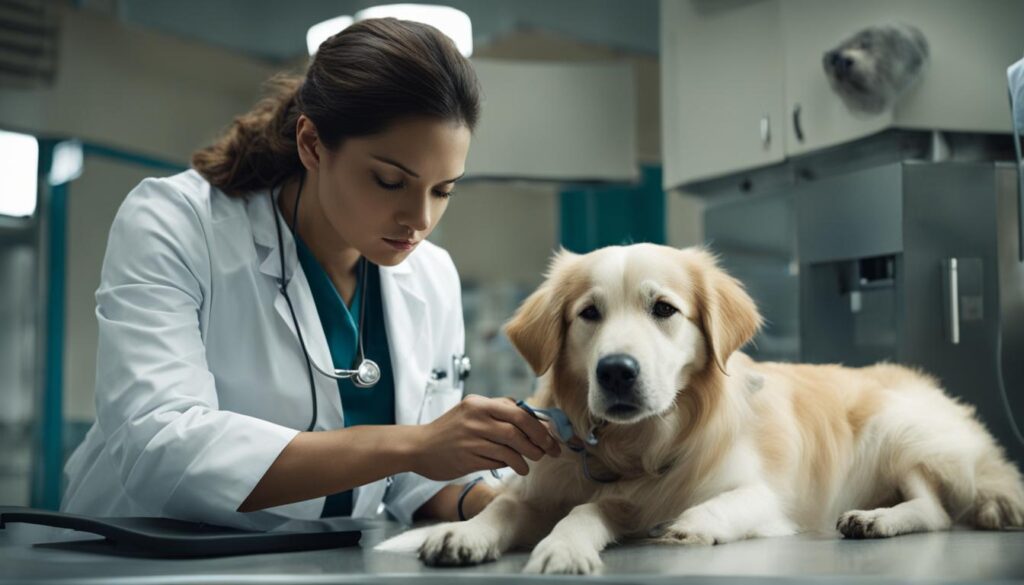
The most common form of treatment for norovirus in dogs is focused on keeping the dog properly hydrated to restore electrolyte balance. Fluids may be administered orally, subcutaneously, or intravenously. Food may be withheld for a couple of days to allow the dog’s stomach to settle, after which a bland and digestible diet may be introduced in small, frequent meals. In cases of bacterial infection, antibiotics may be prescribed. Antidiarrheal medications and probiotics may also be given to help alleviate symptoms.
Norovirus Treatment Options for Dogs
| Treatment Method | Description |
|---|---|
| Fluid Administration | Oral, subcutaneous, or intravenous fluids to ensure proper hydration and restore electrolyte balance. |
| Withholding Food | Temporary no-food period to allow the dog’s stomach to settle before introducing a bland and digestible diet. |
| Bland Diet | Introduction of a gentle and easily digestible diet in small, frequent meals after the fasting period. |
| Antibiotics | Prescribed in cases of bacterial infection or if secondary bacterial complications arise. |
| Antidiarrheal Medications | Medications to help alleviate diarrhea and reduce bowel movements. |
| Probiotics | Supplementation with beneficial bacteria to support gastrointestinal health and restore the gut microbiota. |
Similarities and Differences Between Norovirus in Humans and Dogs
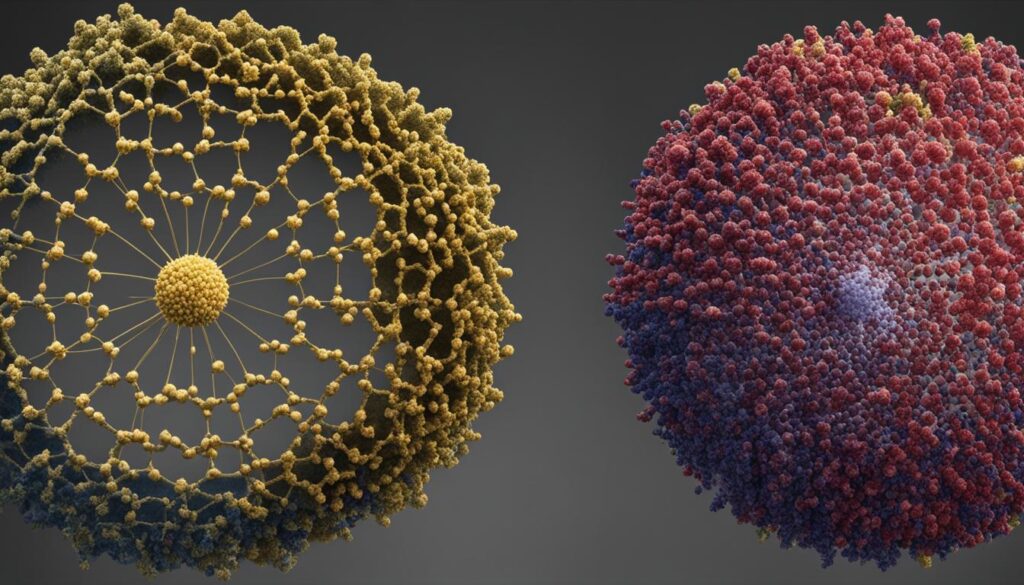
Humans and dogs can both experience episodes of gastroenteritis, a condition characterized by symptoms such as vomiting, diarrhea, loss of appetite, dehydration, lethargy, and abdominal pain. These similarities in symptoms suggest that norovirus, a common cause of gastroenteritis in humans, can also affect dogs to some extent.
However, there are subtle differences in how norovirus manifests in humans and dogs. For example, dogs infected with norovirus are more likely to have blood in their vomit or feces, while many humans may experience a low-grade fever alongside gastrointestinal symptoms.
Another significant difference is that humans have the option of receiving flu shots, which provide some protection against certain strains of the influenza virus but do not prevent norovirus infections. On the other hand, dogs do not receive flu shots, making them more susceptible to norovirus without any preventive measures specifically targeting the virus.
When it comes to diagnosing and treating norovirus in humans and dogs, there are similarities in the approach. Both require proper medical evaluation and care from healthcare professionals or veterinarians, respectively, to confirm the norovirus infection and manage the symptoms accordingly.
Overall, while there are similarities in the symptoms and potential infection of norovirus between humans and dogs, proper diagnosis and treatment tailored to the specific condition of the individual are essential. Consultation with a medical or veterinary professional is crucial for accurate diagnosis, appropriate treatment, and preventive measures for both humans and dogs.
Preventing Norovirus in Dogs

While the risk of norovirus transmission from dogs to humans is still being investigated, it is important to take precautions to protect both yourself and your dog. Gastroenteritis can be a distressing condition for dogs, and preventing norovirus and other causes of gastroenteritis is crucial for their health and well-being.
To prevent norovirus in dogs and reduce the risk of transmission, follow these guidelines:
- Practice good hygiene: Regularly wash your hands with soap and water, especially after handling your dog or cleaning up after them. This helps to remove any potential traces of norovirus or other harmful pathogens.
- Clean and disinfect surfaces: Use a pet-friendly disinfectant to clean areas where your dog spends time, such as their bedding, food bowls, and toys. Pay special attention to areas that may come into contact with bodily fluids.
- Avoid direct contact with bodily fluids: While it may be challenging to completely avoid contact with your dog’s bodily fluids, try to minimize direct exposure. Wear gloves when cleaning up urine, feces, or vomit, and dispose of waste properly.
- Isolate your dog if they show signs of gastroenteritis: If your dog exhibits symptoms such as vomiting, diarrhea, or loss of appetite, isolate them from other pets and humans in your household. This can help prevent the spread of norovirus or other infectious agents.
- Seek veterinary care: If you suspect your dog has norovirus or gastroenteritis, consult a veterinarian for a proper diagnosis and treatment plan. Veterinarians can provide guidance on managing symptoms, preventing dehydration, and ensuring your dog’s overall well-being.
By following these preventive measures, you can help protect your dog from norovirus and reduce the risk of transmission to humans. Remember, a healthy dog is a happy dog!
| Prevention Tips for Norovirus in Dogs | Description |
|---|---|
| Practice good hygiene | Regularly wash hands and clean dog-related surfaces |
| Clean and disinfect surfaces | Use pet-friendly disinfectants to keep the environment clean |
| Avoid direct contact with bodily fluids | Minimize exposure to urine, feces, and vomit |
| Isolate dogs with gastroenteritis symptoms | Prevent the spread of norovirus by separating sick dogs |
| Seek veterinary care | Consult a veterinarian for diagnosis and proper treatment |
Norovirus in Dogs: A Growing Concern
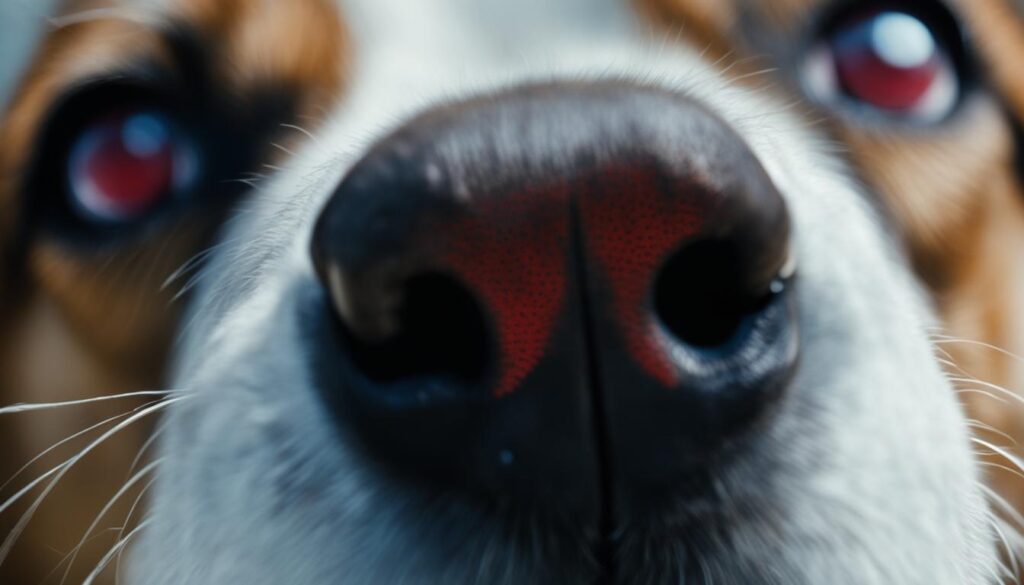
The potential transmission of norovirus between humans and dogs raises concerns about the spread of the virus. While there is currently no evidence that dogs can shed the virus in quantities sufficient to infect humans, further research is needed to understand the potential risks.
Researchers are studying the ability of human norovirus to bind to canine gastrointestinal tissue and the presence of antibodies to human norovirus in dogs’ blood samples. The aim is to gather more data to determine if human norovirus can survive in nonhuman animals and spread from them to people.
By studying how norovirus interacts with dogs at a molecular level, scientists can gain valuable insights into the potential risks and develop targeted prevention strategies. This research will contribute to a better understanding of norovirus transmission and help safeguard both human and canine health.
Wrapping Up
In conclusion, norovirus is a significant cause of gastroenteritis in humans and has the potential to affect dogs as well. Research suggests that humans may be able to pass norovirus to dogs, but further investigation is required to fully understand the risk of transmission from dogs to humans. It is essential for dog owners to practice good hygiene, including regular handwashing and disinfecting surfaces, especially when gastroenteritis is present in the household.
If your dog exhibits symptoms of gastroenteritis, such as severe vomiting and diarrhea, it is crucial to seek veterinary care for a proper diagnosis and treatment plan. Remember that symptoms of norovirus can also be caused by other factors, so a veterinarian’s expertise is essential for an accurate diagnosis.
As the research on norovirus in dogs continues to evolve, it becomes increasingly important to take appropriate preventive measures. This includes following hygiene precautions, isolating infected dogs, and consulting a veterinarian for guidance. By staying informed and proactive, we can safeguard both our own health and the well-being of our furry companions.
FAQ
Can dogs get norovirus?
Recent research suggests that dogs may be able to contract and potentially transmit the human norovirus. While no evidence has been found that dogs can shed the virus in quantities sufficient to infect humans, further investigation is warranted to understand the potential risks of dogs transmitting norovirus to humans.
Can humans pass norovirus to dogs?
Yes, recent studies have found dogs with human norovirus in their stool samples, indicating that they may have been infected by the virus. Kennel outbreaks have also been traced to pregnant dogs who were moved from the kennel to live indoors with infected people, resulting in the transmission of norovirus to both the dogs and the puppies they birthed.
What are the symptoms of norovirus in dogs?
Dogs infected with norovirus may exhibit symptoms similar to those seen in humans with gastroenteritis. These symptoms may include severe vomiting and diarrhea, dehydration, loss of appetite, lethargy, blood in feces or vomit, abdominal pain, and weakness. It is important to note that these symptoms can also be caused by other conditions and a proper diagnosis from a veterinarian is necessary to confirm norovirus infection.
How is norovirus in dogs diagnosed?
Diagnosing norovirus in dogs requires a thorough examination by a veterinarian. The most common sign of gastroenteritis in dogs is the sudden onset of severe vomiting and/or diarrhea. A veterinarian will likely ask questions about the dog’s diet, potential exposure to norovirus-infected individuals, recent episodes of vomiting or diarrhea, and any medications the dog may be on. The vet may also run blood tests, order x-rays or scans, perform electrolyte tests, and conduct a urinalysis to check for any imbalances or underlying medical conditions.
What is the treatment for norovirus in dogs?
The most common form of treatment for norovirus in dogs is focused on keeping the dog properly hydrated to restore electrolyte balance. Fluids may be administered orally, subcutaneously, or intravenously. Food may be withheld for a couple of days to allow the dog’s stomach to settle, after which a bland and digestible diet may be introduced in small, frequent meals. In cases of bacterial infection, antibiotics may be prescribed. Antidiarrheal medications and probiotics may also be given to help alleviate symptoms.
What are the similarities and differences between norovirus in humans and dogs?
Humans and dogs both experience episodes of gastroenteritis and exhibit similar symptoms, including vomiting, diarrhea, loss of appetite, dehydration, lethargy, and abdominal pain. However, there are subtle differences in how norovirus affects humans and dogs. Dogs are more likely to have blood in their vomit or feces, while many humans may have a low-grade fever. Additionally, dogs do not receive flu shots, which are available to humans. It is important to consult a veterinarian for a proper diagnosis and treatment plan tailored to your dog’s specific condition.
How can norovirus in dogs be prevented?
While the risk of norovirus transmission from dogs to humans is still being investigated, it is important to take precautions to protect both yourself and your dog. Practice sensible hygiene precautions, especially when gastroenteritis is present in your household. This includes regular handwashing, cleaning and disinfecting surfaces, and avoiding direct contact with bodily fluids or contaminated objects. Isolate your dog if they show signs of gastroenteritis and seek veterinary care for a proper diagnosis and treatment plan.
Why is norovirus in dogs a growing concern?
The potential transmission of norovirus between humans and dogs raises concerns about the spread of the virus. While there is currently no evidence that dogs can shed the virus in quantities sufficient to infect humans, further research is needed to understand the potential risks. Researchers are studying the ability of human norovirus to bind to canine gastrointestinal tissue and the presence of antibodies to human norovirus in dogs’ blood samples. The aim is to gather more data to determine if human norovirus can survive in nonhuman animals and spread from them to people.
Any final thoughts on norovirus in dogs?
Norovirus is a significant cause of gastroenteritis in humans and may also affect dogs. While research suggests that humans may be able to pass norovirus to dogs, the risk of transmission to humans from dogs is still being studied. It is important to practice good hygiene and seek veterinary care if your dog exhibits symptoms of gastroenteritis. Further investigation is needed to fully understand the potential risks and take appropriate preventive measures.


